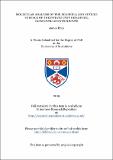Files in this item
Molecular analysis of the eggshell and cuticle surface of the potato cyst nematode, Globodera rostochiensis
Item metadata
| dc.contributor.advisor | Jones, John T. | |
| dc.contributor.author | Price, James A. | |
| dc.coverage.spatial | xxiv, 260 p. | en_US |
| dc.date.accessioned | 2019-08-05T13:44:27Z | |
| dc.date.available | 2019-08-05T13:44:27Z | |
| dc.date.issued | 2019-12-03 | |
| dc.identifier.uri | https://hdl.handle.net/10023/18248 | |
| dc.description.abstract | Plant-parasitic nematodes regulate their interactions with the external environment and their host. The surface of the nematodes, whether the cuticle or the eggshell, plays a key role in this process. Work undertaken in this project aimed to exploit new genome resources for potato cyst nematodes (PCN) to allow characterisation of these structures. The eggshell is a key survival structure for PCN. Hatching of juvenile potato cyst nematodes occurs in response to host derived hatching factors. Little is known about the molecular mechanisms that underpin hatching in response to these host diffusates and nothing is known about the molecular composition of the PCN eggshell. Methods that allow extraction of proteins and lipids from large numbers of isolated PCN eggshells were developed. These extraction techniques permitted identification of a range of proteins present in the eggshell, including chondroitin proteoglycans and a calcium dependent phospholipid-binding annexin. The annexin was focused on due to the apparent major role of calcium in PCN hatching. This annexin was localised to the eggshells of Globodera rostochiensis by immunofluorescence. To our knowledge, this makes the annexin the first eggshell protein to be identified and localised in any plant-parasitic nematode. The annexin was shown to bind to phospholipids and RNAi of the annexin showed that reducing expression of the eggshell annexin alters nematode hatching patterns in response to host hatching factors. The eggshell permeability barrier is essential for the development of a juvenile within the embryo. Eggshell lipid analysis has given insight into components of the permeability barrier. Identified lipid species highlight potential function within the nematode hatching cascade through calcium interaction or down stream signalling. Attempts to identify the presence of nematode specific glycolipids, ascarosides, within the PCN eggshell showed that ascarosides or ascarylose were not detectable within PCN eggs, cysts or juveniles. It has previously been shown that the infective juveniles are able to alter their surface composition to avoid damage from host defence mechanisms. Here, methods that allow labelling of proteins present on the cuticle surface of PCN were developed. Three proteins; Galectin-5, Cri-2 and a nematode specific hypothetical protein that are present on the surface of PCN second stage juveniles were further investigated. These proteins were tested for their potential to suppress host defences through a variety of protein-small molecule interactions. This analysis showed that surface coat associated galectins could offer protection to an invasive juvenile through sequestering cell wall breakdown products, silencing detection of the pathogen. | en_US |
| dc.language.iso | en | en_US |
| dc.publisher | University of St Andrews | |
| dc.relation | Molecular analysis of the eggshell and cuticle surface of the potato cyst nematode, Globodera rostochiensis (thesis data) Price, J.A., University of St Andrews, 2019. https://doi.org/10.17630/1640cfe0-43b2-4221-b997-8497d5e055bf | en |
| dc.subject | PCN | en_US |
| dc.subject | Eggshell | en_US |
| dc.subject | Cuticle | en_US |
| dc.subject.lcc | QL391.N4P8 | |
| dc.subject.lcsh | Golden nematode | en |
| dc.subject.lcsh | Golden nematode--Eggs--Incubation | en |
| dc.subject.lcsh | Eggshells | en |
| dc.subject.lcsh | Cuticle | en |
| dc.title | Molecular analysis of the eggshell and cuticle surface of the potato cyst nematode, Globodera rostochiensis | en_US |
| dc.type | Thesis | en_US |
| dc.contributor.sponsor | Perry Foundation (Great Britain) | en_US |
| dc.type.qualificationlevel | Doctoral | en_US |
| dc.type.qualificationname | PhD Doctor of Philosophy | en_US |
| dc.publisher.institution | The University of St Andrews | en_US |
| dc.publisher.department | The James Hutton Institute | en_US |
| dc.identifier.doi | https://doi.org/10.17630/10023-18248 |
This item appears in the following Collection(s)
Items in the St Andrews Research Repository are protected by copyright, with all rights reserved, unless otherwise indicated.

